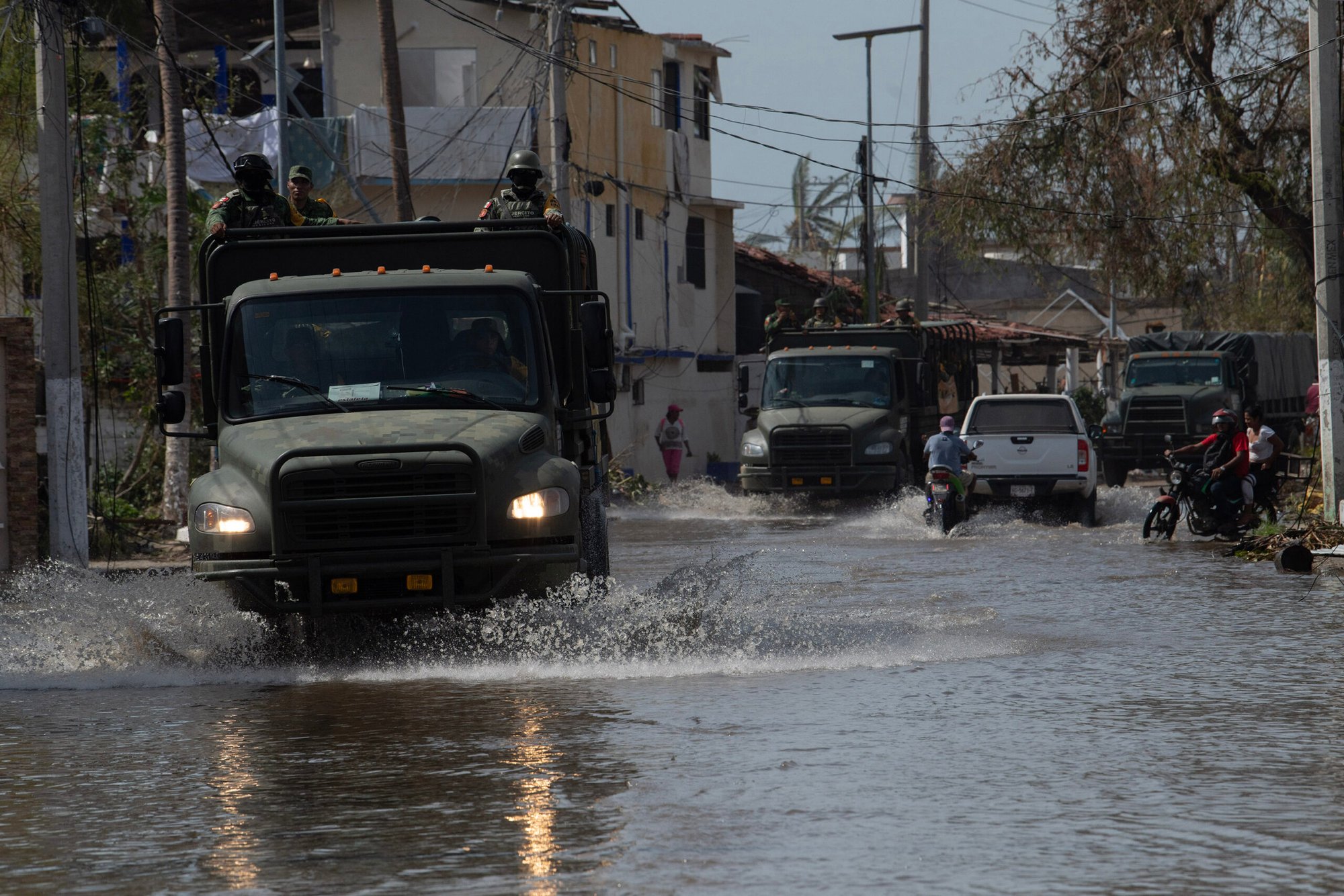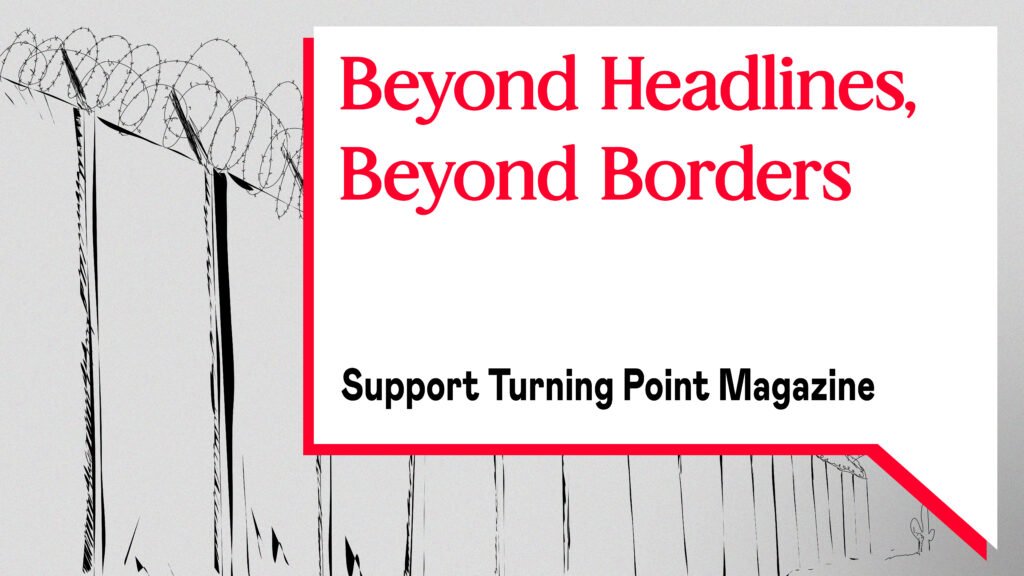Cover photo: A military convoy driving through the flooded streets of Pie de la Cuesta, in the western part of Acapulco, on October 27, 2023. The Mexican Army and Navy are deployed as part of the DN-III plan in natural disasters or situations where the safety of the population is threatened. © Miguel Dimayuga
Force, in the hands of another, exercises over the soul the same tyranny that
extreme hunger does; for it possesses, and in perpetuo, the power of life and death.
Its rule, moreover, is as cold and hard as the rule of inert matter.
– The Iliad, or The Poem of Force, Simone Weil, 1939
The global rise of fascism, right-wing populism, climate-related disaster, and militarization together reflect the logical outcome of the ongoing neoliberal consensus—one made possible by the obstruction of any cohesive leftist agenda. Given this depressing political-economic trajectory, I find myself returning frequently to Simone Weil’s philosophical meditation on sovereignty and the dehumanizing power of force, which transforms anyone subjected to it into an object in its path. Written amid the fall of France’s Troisième République to Nazi Germany, Weil reconstructs Homer’s Iliad with a paradox, centering the soldier as both wielder of the sword and vulnerable to its blade. Where the state relies on violence and individual subjugation, this duality reveals the moral and political-economic dilemmas inherent in the militarization of state and public functions.
Weil’s thinking maintains relevance today, especially where climate-related disaster disrupts—and then requires—security. A critical examination of how power is exercised through force and the impacts it has on individual agency, state sovereignty, and human morality is both timely and necessary. What are the political imperatives for care in a catastrophe for those subjected to force at the hands of the state and global capital? This is a relevant question for organizers and academics—although how the impact is evident in the militarization of disaster recovery may not be immediately apparent. One thing is certain: as long as we don’t have an alternative political economy built around equitable resource distribution, collective care, economic security and equality for everyone; any disciplined humanitarian presence intended to restore order amid disaster does so in service to capital and capital alone.
To start, disasters themselves are not any more “natural” than the conditions that drive them, but rather the consequence of risks intensified by market-oriented state policies and extractive global processes. Foremost of these are state-enabled oil companies, but also the multi-billion dollar US-based war machine and, more recently, the mega-consumption of energy and resources tied to generative AI. When these risks culminate in disaster—lately in the form of one “unprecedented” event after another—those same states send the military to manage the fallout, provide relief, and maintain order. In the United States, for instance, the National Guard is deployed immediately after a disaster along with militarized aid from other agencies as emergency management protocol.
In Global Southern contexts, military force is more often tied to historical legacies of nationalism and social control, where it mediates creative destruction—the relentless process whereby new technologies and economic changes constantly dismantle and rebuild social and economic structures—and the subtle, manipulative influence of development banks and financial institutions. In occupied or otherwise debt-dependent states across the Global South, military force secures global capital, maintains social and economic hierarchies, and ensures economic continuity under the guise of protective care. In post-disaster conditions, this transforms Weil’s soldiers of force into instruments of securitized care, reducing everyone involved to extensions of the state and its assets.
While I am drawn to Weil’s socialism of compassion, there is also excellent contemporary academic work that engages with the inequalities exposed by militarized humanitarian aid and violence-as-care where it is practiced. Taken together, I see this convergence of critical thought as a politics of force that can be encountered nearly everywhere now as we collectively spiral along neoliberalism’s inevitable path.
There are—and will continue to be—examples of how this politics plays out, but here I want to talk about Mexico, where the first of what will certainly be more “unprecedented” hurricanes struck the resort city of Acapulco in late October 2023. Reconstruction efforts in and around the city not only expose economic disparities within Acapulco’s tourist economy and uneven development practices but also exemplify the growing prevalence of military force in disaster recovery generally.
Militarization Under Morena
Hurricane Otis was a tropical cyclone without precedent. It made landfall directly on the beach resort city of Acapulco as a Category 5 hurricane, with sustained winds of up to 265 kph, and gusts of up to 330 kph. The storm caused catastrophic damage, destroying beaches, and wrecking the city’s main shopping district, waterfront properties, and countless informal residences. It was the strongest hurricane on record on Mexico’s Pacific coast, with an extremely rapid intensification that caught both experts and residents off guard. Ultimately, at least 27 people were killed and hundreds of families were displaced by the storm.
The total damage from Hurricane Otis has been estimated at $12-16 billion, making it the costliest hurricane to hit Mexico. This drastically exceeds the maximum $125 million in coverage promised by Mexico’s 2020 World Bank catastrophe bond, which only paid out 50% of the insured amount for Otis, because the storm’s central pressure did not fall within the thresholds necessary to meet the bond’s problematic parametric criteria. In addition to this shortfall, Mexico did not earmark further funds in its 2024 budget for recovery. With the scale of destruction exceeding the country’s disaster response capabilities, Mexico has had to rely on ad-hoc budget resources, humanitarian aid, and private donations.
In these austere recovery conditions, the Mexican government deployed the National Guard to Acapulco almost immediately after Otis subsided as it moved north and fizzled out over the mountainous terrain along the coast. The military was originally tasked with overseeing humanitarian aid distribution, handing out bottles of water and packets of food to residents. However, since then, the government has unfolded plans to establish a permanent military presence in Acapulco, a move representing a broader trend toward securitized force in Mexico, but one with implications for disaster governance, too.
Militarization in Mexico has intensified under the presidency of Andrés Manuel López Obrador (AMLO) and his oft-misidentified “left” populist Morena party. Since AMLO’s election in 2018, Mexico has seen a significant expansion of the military into governance structures and everyday life, along with increased military involvement in safeguarding critical infrastructure and natural resources. Under AMLO’s government, the Mexican Senate ratified an initiative that formalizes the assignment of the National Guard to the Ministry of National Defense (Sedena), making its military charter official, and raising concerns about past and potential human rights violations. This National Guard was supposed to be civilian-led but it has operated under the purview of the Army almost since its inception in 2019.
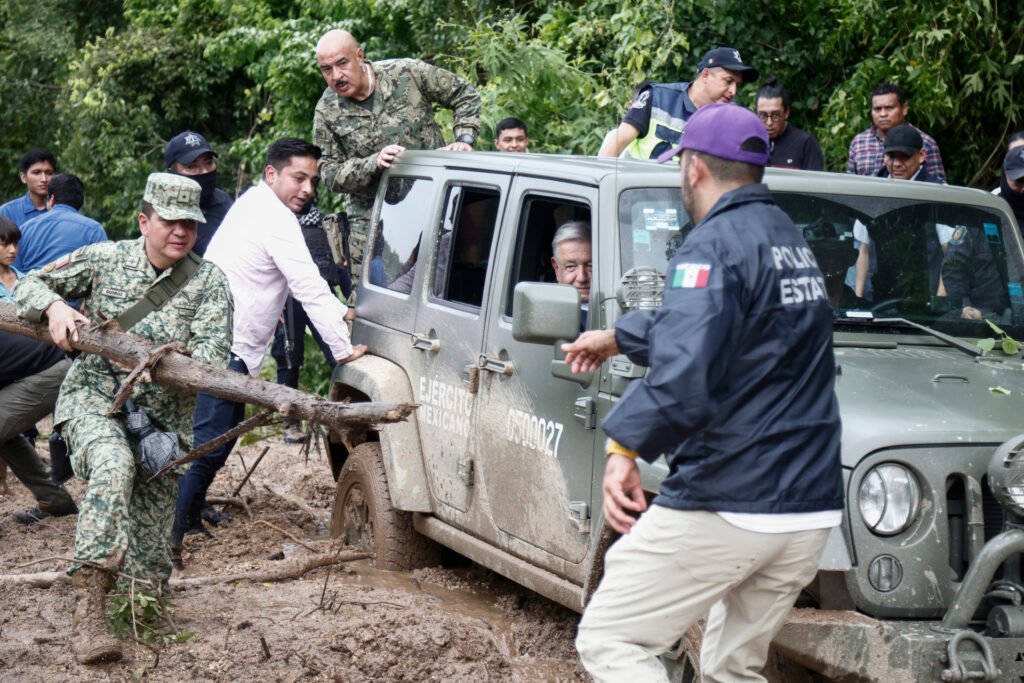
It isn’t just the militarization of public security that raises alarms, but also its role in the reorganization of Mexico’s state functions. AMLO has moved to nationalize resources and has publicly criticized the neoliberal policies of past presidents. In doing so, he has claimed to move Mexico beyond the effects of Bretton Woods and its neoliberal agenda. However, his administration is characterized by institutionalized austerity measures, harmful immigration policy, and bureaucratic restructuring that has been heavily criticized by government officials, citizens, and leftists in Mexico and internationally. Meanwhile, Mexico’s military spending has increased by over 150% since Morena came to power.
These trends will continue under the newly-elected President Claudia Sheinbaum, a former Mexico City governor, Morena spokesperson, and now Mexico’s first woman head of state. While Sheinbaum is frequently incorrectly touted as a “leftist” and a “climate scientist” by Western media and hopeful progressives, she has been instrumental in developing and maintaining AMLO’s problematic political project. Sheinbaum inherited a state in political disarray, with inadequate long-term disaster recovery conditions—not just in Acapulco, but in cities and towns throughout the country. More than anything else, her election ensures the continuation of AMLO’s austerity measures and the ongoing militarization of the Mexican state under Morena.
Importantly for Acapulco, Morena’s agenda has made disaster recovery more difficult. The dismantling of Mexico’s disaster governance structures—particularly of the Fonden disaster trust fund and program—is a critical point that will haunt Sheinbaum’s term as well. Fonden, while flawed, was a crucial mechanism for funding disaster response and recovery that provided dedicated resources for reconstruction and rehabilitation efforts. Its reorganization into a budget line within the treasury and shifting disaster recovery responsibilities to the Civil Protection Secretariat are not unlike the US government’s restructuring of FEMA under Homeland Security in 2001—just more evidence of a general normalization of militarized disaster governance.
Two Acapulcos
Acapulco de Juárez, or simply Acapulco, is a seaport city in the state of Guerrero, where it is exposed to hazards like hurricanes and earthquakes due to its geographic location. The city’s disaster risk is further complicated by inter-cartel, police, and military violence. More than 50 politicians and candidates were killed in the run-up to the 2024 elections in Guerrero alone—mostly political candidates related to Claudia Sheinbaum’s presidential run. Hurricane Otis was devastating for Acapulco, but a closer look reveals how this politics of force is exposed and disrupted by the crisis.
The thing is, Acapulco is really two cities—one rich and one poor—that work together to produce and maintain a tourist economy that generates tons of revenue for Mexico and foreign firms. The “rich” Acapulco is an affluent resort city that caters to wealthy US and European tourists, affluent visitors from Mexico City, and rich immigrants. The tourist economy features luxury shopping, white-sand beaches, historic heritage sites, and activities like walking tours, snorkeling, boat rides, sightseeing cruises, and incredible athletic spectacles like the famous calavistas de la Quebrada (cliff divers of Quebrada) that draw crowds and generate income through ticket and souvenir sales. Luxury cruise liners once regularly stopped over in Acapulco, although the city’s reputation for violence and safety concerns since Otis have contributed to diminished frequency.
To maintain and grow these attractions and safeguard their economic impact, financing includes ongoing tourism investment and cultural projects, along with “sustainable investment” in the region. This kind of investment has persisted as part of Acapulco’s rebuilding strategy and development-led recommendations for reconstruction, despite some private firms exercising caution around increased violent crime in the wake of the storm.
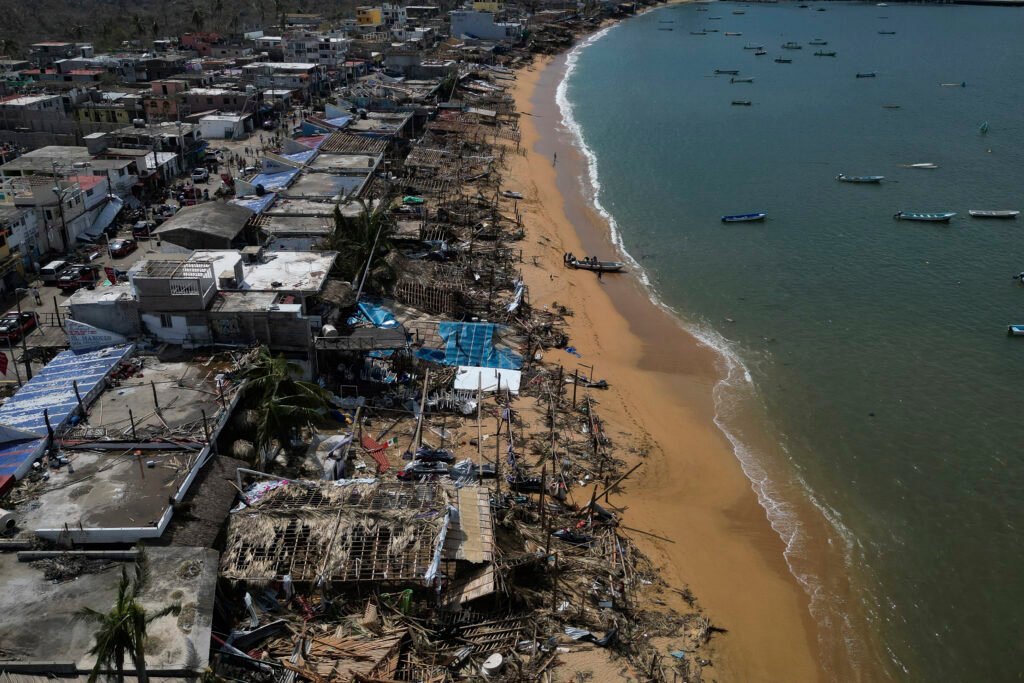
The “poor” Acapulco comprises a vast network of hospitality, service, and informal labor doing the behind-the-scenes work of producing the city’s tourist economy. The state of Guerrero contributes approximately 1.4% to Mexico’s overall GDP, a contribution largely based on tourism in Acapulco. The informal economy in Acapulco makes up a significant part of the local economy in the city. Close to 80% of workers in Acapulco are informally employed, while only a bit over 20% work in the formal sector.
Most informal workers are self-employed beach vendors, and of these, most are women selling various goods and services—jewelry, hair braiding, massage, snacks, and mixed drinks from coolers—to tourists. These vendors and others engaged in unregulated income-generating activities are not covered by the labor regulations that promise safety, overtime, or minimum wage requirements, but their work and presence in the city define the experience for visiting tourists—for better or for worse.
Disaster Militarization “on the Ground”
In the aftermath of Hurricane Otis, under the direction of then-president AMLO, the National Guard quickly assumed a central role in directing recovery resources, distributing aid (food, water, etc.), and prioritizing the restoration and securitization of “rich” Acapulco’s tourist infrastructure to keep it up and running. In the immediate aftermath of the storm, “looting” and local conflicts did indeed erupt, although these instances seem reasonable in response to limited aid and resources. The power was out for weeks, causing fear and panic among residents who felt defenseless to protect what little they had against the ever-present threat of violence well known in Acapulco. Reports of uneven distribution of aid and resources are common, indicating a fraught recovery process.
In the months following the disaster, I spoke with a few people affected by Hurricane Otis. Two key issues emerged from these conversations: the pervasive presence of soldiers and the growing pressure from organized crime, as well as the impact of austerity on recovery funding. Each of these factors contributes to a cycle of insecurity, reinforcing the need for the other.
Since the early 2000s, Western media has portrayed Acapulco as a “faded resort city” and the “murder capital” of Mexico. This shift in perception coincided with the intensification of US-Mexico border relations due to the war on drug trafficking. As efforts to combat drug trafficking ramped up, violence between rival cartels and state forces escalated, drawing significant international attention. Acapulco, famous throughout the mid-20th century as a glamorous destination for Hollywood stars and luxury tourism, instead became notorious for its high crime rates and brutal violence, overshadowing its previous reputation. This negative portrayal reflects the broader impact of the drug war on Mexico’s international image and tourism industry.
Even before Otis, tourism websites targeting foreign visitors have consistently warned of ongoing safety concerns, indicating the presence of gang conflicts and a mantle of violent potential in and around Acapulco. The state of Guerrero is listed on the United States’ “Do Not Travel” advisory—ironically so, since much of the cartel violence in Mexico is arguably fueled by US drug demand and access to US guns. This relationship in large part underpins Mexico’s politics of force and its justification for military spending, where it is estimated that up to half a million weapons are smuggled from the US to Mexico each year. The US arms the cartels and contributes to the spiraling violence, and as such bears responsibility for the cartel crisis in Mexico, as the consumer demand and lax gun laws north of the border enable the cartels’ deadly operations.
While I want to specify that these outcomes are not formed in a vacuum, I do not mean to downplay Acapulco’s reputation for violent or coercive crime—it is real and it is dangerous. One story that stood out to me is how organized crime has been able to seize opportunities for land grabs along the coast in the wake of Hurricane Otis. In February, a friend shared videos of her cousin’s beachfront condo showing how the entire building had been decimated: windows blown out, balconies just gone, personal items and furniture strewn about, garbage and debris lined the shore. “Depending on your mortgage, the bank will buy back your property after a big disaster, but the men from the cartels offer more,” she explained in a hushed voice, “and it’s not an offer you can decide on. You just do it, you sell.”
Similarly, another friend whose family lives in Guerrero told me that as recently as April 2024 “people are still hanging out in long aid lines every day” while armed soldiers both distribute and guard the provisions. “People are open and willing to talk, and no one feels the aid is enough. People are struggling to get food because what they give out isn’t enough” and “their lives have been destroyed, like their restaurants and (now they are) selling things on the street, it’s impossible and dangerous over there.”
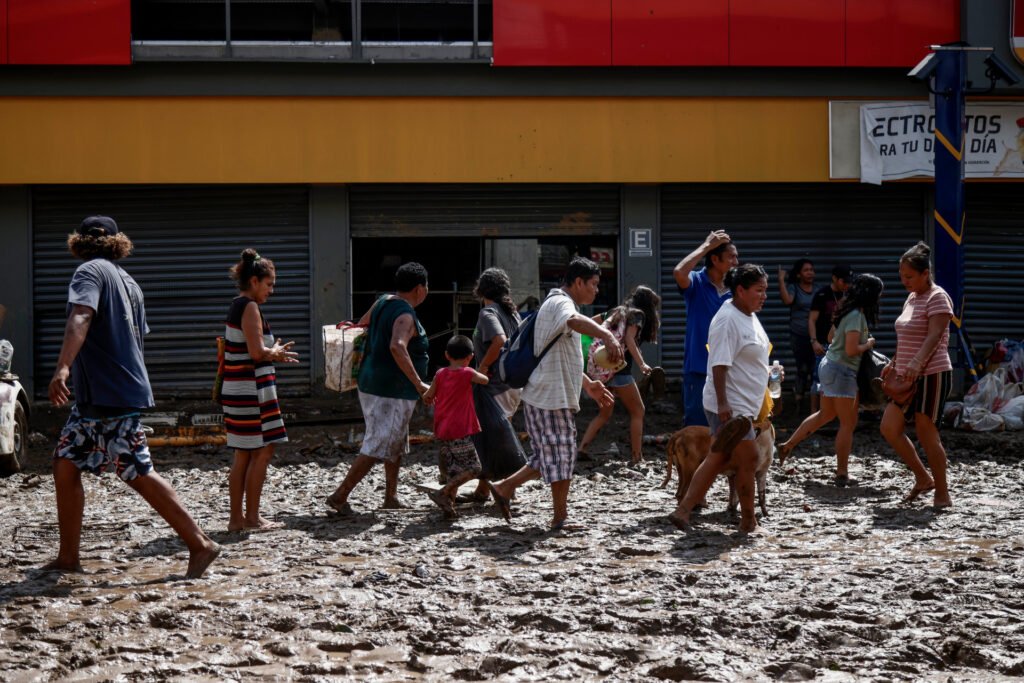
Today, over nine months have passed since Otis made landfall. Meanwhile, a visible military presence persists in the city, ensuring at least performatively that the “rich” Acapulco is secured and that attractive conditions for investment in its tourism economy are prioritized. My preliminary investigation shows that development-brokered (e.g. World Bank sponsored) reconstruction finance has fallen short, and the state has failed to earmark sufficient recovery funds. Meanwhile, those living in “poor” Acapulco are left to improvise their recovery through forms of infrastructural labor that are mediated by both state and development institutional symbols of violence.
Disaster and the Politics of Force
Under the auspices of security and humanitarian aid, military-led efforts to rebuild and fortify Acapulco’s affluent areas have been slow and entangled, focusing on “rich” Acapulco while marginalizing the needs of poorer families and neighborhoods. Weil’s meditation on the dehumanizing power of force can be seen in the aftermath of disasters and in the experiences of military personnel, where individuals may feel powerless and reduced to their basic physical needs.
The involvement of the National Guard in Acapulco’s reconstruction is part of a broader shift toward militarization in Mexico, representing a significant transfer of power to the armed forces and solidifying their role as major political and economic players in Mexico for the foreseeable future. Operating under the auspices of “aid” and “security,” the military’s role tells an interesting story about care and state responsibility. However, the entanglement of militarized recovery efforts with the limitations of development-brokered financial instruments and state divestment from non-military aid has reproduced existing risks and expanded spaces of precarity in “poor” Acapulco.
The military, while enforcers, are also ensnared in the same mechanisms that make up the politics of force. Their humanity is compromised as they become agents of a system that dehumanizes both those they control and themselves. This is the nature of rationality, which attempts to flatten the real world through discipline. The military is nothing if not a rational force, easily deployed, organized, and easy to control, reflecting Weil’s insight: the sword’s wielder is as bound by its power as those upon whom it is wielded. State deployment of military force in disaster zones shows how the drive for order and security often comes at the cost of compassion and genuine relief—especially where rationality cannot map onto informal or irregular conditions—reducing all involved to mere components of a larger, relentless machine.
The current recovery strategies in Acapulco foreshadow unsustainable climate futures for the entire city that could be a canary in the coal mine for other countries of the Global South. By securing the needs of “rich” Acapulco through the auspices of militarized violence and care in Mexico’s austere political-economic context, the long-term socio-economic and environmental landscape of the city is at risk. These unequal efforts are likely to result in future challenges, exacerbating existing socio-economic vulnerabilities to current conditions and future risks in a climate-changing world. As a case in point, there are over 1,000 listings in Acapulco on AirBnB as of July 2024. This feeds concerns about a growing “climate apartheid” scenario, where the wealthy can insulate themselves from the impacts of climate change or at least continue life as usual—while the rest of the world is left behind to bear the brunt of the consequences.
Typical resilient “build back better, build back stronger” messages of hope have been contested repeatedly in the social sciences for assuming some baseline of normalcy within a global political economy that requires poverty for capital to persist. Weil’s analysis of the Iliad highlights the cyclical nature of violence, where acts of force beget further acts of force. This cycle can be observed in the aftermath of disasters, where communities struggle to recover and rebuild, or in the ongoing conflicts that often necessitate military intervention.
Beyond Weil, Gill Hart’s influential treatise directs us to Gramsci, urging an internationalist approach to analyzing “relations of force” that are intertwined with state politics. These are entanglements that stink of capital accumulation, the sole driver behind the politics of force in practice—a force, once unleashed, that engulfs everyone in its path, leaving both the wielder and the victim diminished, soulless, and hollowed out. With the force of militarization, organized crime, and systemic neglect of the poor in Acapulco, I offer my own humble call to action—an appeal to the left in all corners of practice and politics. Without addressing the deeper global political-economic issues that have normalized risk for the world’s poorest people, cycles of violence and insecurity like these will continue, undermining pathways to justice for the most vulnerable before it comes for us all.

Beki McElvain
Beki McElvain, PhD, is an economic geographer and ethnographer specializing in the political economy of development, climate, and disaster governance in the global South. McElvain lives and works in Mexico City.
